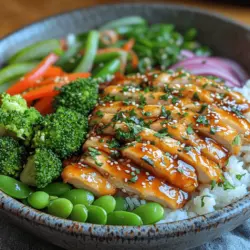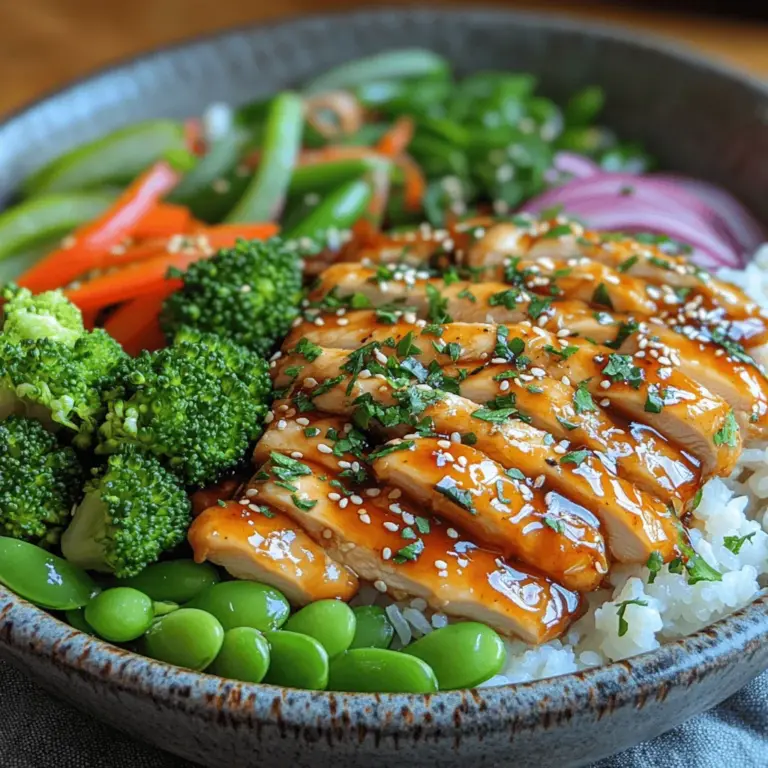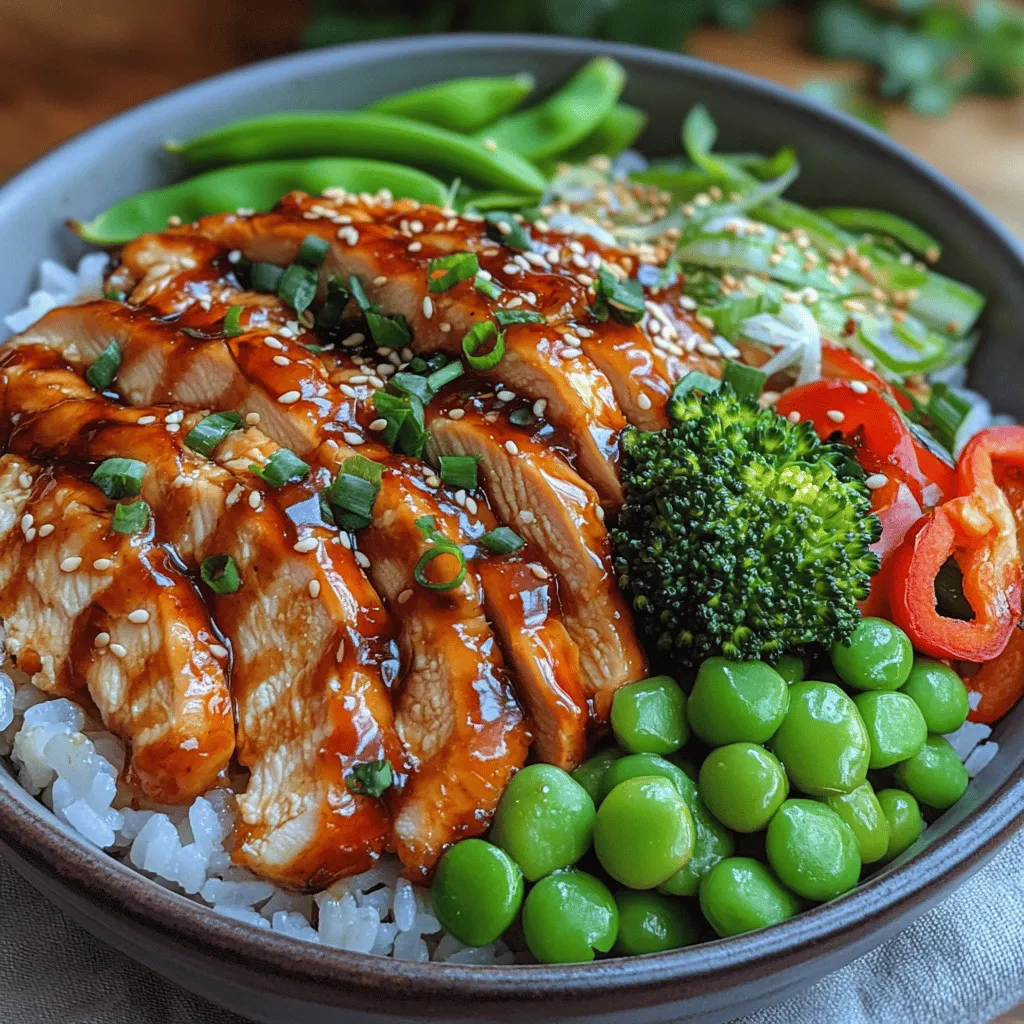Introduction
In the vibrant world of Japanese cuisine, few dishes capture the essence of flavor and satisfaction quite like Teriyaki Chicken Rice Bowls. This delightful dish marries tender, marinated chicken with a savory-sweet teriyaki sauce, served over a bed of fluffy rice and accompanied by fresh vegetables. Teriyaki Chicken Rice Bowls are not just a treat for the taste buds; they also embody a perfect balance of flavors that appeal to food lovers everywhere.
The flavor profile of Teriyaki Chicken is a symphony of sweet, salty, and umami notes, making it a favorite among those who seek hearty yet healthy meals. The savory sauce, often made from soy sauce, mirin, and sugar, coats the chicken beautifully, creating a delicious glaze that elevates the dish to a culinary experience. Beyond its palate-pleasing qualities, this dish is a nutritional powerhouse, rich in protein and vitamins, thanks to the inclusion of fresh vegetables.
One of the greatest advantages of Teriyaki Chicken Rice Bowls is their versatility. You can serve them as a quick weeknight dinner, a meal prep option for busy days, or even as a centerpiece at gatherings with family and friends. The best part? They are incredibly easy to prepare, making them accessible to home cooks of all skill levels. Whether you’re a seasoned chef or a novice in the kitchen, this recipe will guide you through creating a dish that is both satisfying and impressive.
Understanding Teriyaki Sauce
To truly appreciate Teriyaki Chicken Rice Bowls, one must first understand the star of the show: teriyaki sauce. Originating in Japan, teriyaki sauce has become a beloved staple in various cuisines around the world. The term “teriyaki” itself refers to the method of cooking, which involves grilling or broiling food while being glazed with a sweet soy sauce mixture. The sauce’s origins can be traced back to the early 17th century, where it was used to enhance the flavors of grilled fish and meat, showcasing the Japanese culinary art of balancing flavors.
The key ingredients that make teriyaki sauce unique are soy sauce, mirin (a sweet rice wine), and sugar. This combination creates a rich, glossy glaze that adds depth to dishes. The balance of flavors is essential; the salty notes from the soy sauce harmonize beautifully with the sweetness of the mirin and sugar, creating a well-rounded sauce that is both delicious and versatile.
When it comes to teriyaki sauce, there is a significant difference between homemade and store-bought varieties. While store-bought sauces can be convenient, they often contain preservatives and artificial ingredients that can detract from the authentic taste. Making your own teriyaki sauce at home allows you to control the ingredients, ensuring a fresher and more flavorful outcome. Plus, it’s a simple process that can take just a few minutes, leading to a more satisfying and wholesome dish.
Ingredients Breakdown
Now that we’ve touched on the allure of teriyaki sauce, let’s delve into the essential ingredients that come together to create Teriyaki Chicken Rice Bowls. Understanding the role of each ingredient will not only enhance your cooking experience but also allow you to customize the dish to your liking.
The star ingredient, of course, is the chicken. You have the option of using chicken thighs or breasts, each offering its own unique qualities. Chicken thighs are known for their rich flavor and juiciness due to their higher fat content, making them ideal for grilling and marinating. On the other hand, chicken breasts are leaner and provide a healthier option, perfect for those looking to reduce fat intake. Both cuts will absorb the teriyaki sauce beautifully, resulting in a flavorful dish.
Next, we have the key players in the teriyaki sauce itself: soy sauce, mirin, and brown sugar. Soy sauce, a staple in Japanese cooking, provides the salty backbone of the sauce, while mirin adds a touch of sweetness and acidity that brightens the overall flavor. Brown sugar contributes a deeper sweetness and caramelization when cooked, enhancing the glaze of the chicken.
Fresh ingredients are crucial for achieving the best results in your Teriyaki Chicken Rice Bowls. Garlic and ginger are essential aromatics that not only add depth to the marinade but also impart their health benefits. Garlic is known for its immune-boosting properties, while ginger aids digestion and has anti-inflammatory effects. Additionally, incorporating a variety of colorful vegetables such as bell peppers, broccoli, and snap peas not only enhances the visual appeal of the dish but also boosts its nutritional profile. These vegetables provide essential vitamins and minerals, making your meal wholesome and fulfilling.
Nutritionally, chicken is an excellent source of protein, essential for muscle repair and overall health. A serving of chicken can provide a significant amount of your daily protein needs, making it a great choice for a filling meal. The addition of fresh vegetables contributes fiber, vitamins A and C, and antioxidants, ensuring you’re not only enjoying a flavorful dish but also nourishing your body.
Marinating the Chicken
Marinating the chicken is a crucial step in preparing Teriyaki Chicken Rice Bowls. This process enhances the flavor and tenderness of the meat, allowing the teriyaki sauce to penetrate deeply. A well-marinated chicken will yield a juicier and more flavorful result, making every bite a delight.
To create the marinade, start with a simple blend of soy sauce, mirin, brown sugar, minced garlic, and grated ginger. This combination captures the essence of teriyaki sauce and infuses the chicken with rich flavors. Here’s a step-by-step guide to creating the marinade:
1. Gather Ingredients: In a mixing bowl, combine 1/4 cup of soy sauce, 1/4 cup of mirin, and 2 tablespoons of brown sugar. Add minced garlic (2-3 cloves) and grated ginger (1 tablespoon) for added depth of flavor.
2. Mix Well: Whisk the ingredients together until the sugar has dissolved, and the mixture is well combined. This ensures that the flavors meld beautifully before they come into contact with the chicken.
3. Prepare the Chicken: Place your choice of chicken (thighs or breasts) in a resealable plastic bag or a shallow dish. Pour the marinade over the chicken, making sure it’s evenly coated.
4. Seal and Refrigerate: If using a bag, seal it tightly, removing as much air as possible. If using a dish, cover it with plastic wrap. Allow the chicken to marinate in the refrigerator for at least 30 minutes, though for optimal flavor, aim for 2-4 hours. If you have the time, marinating overnight will yield even better results.
5. Plan for Variations: Feel free to experiment with the marinade by adding sesame oil for a nutty flavor or a splash of rice vinegar for an extra kick. You can also adjust the sweetness by varying the amount of brown sugar according to your preference.
By following these steps, you will create a deliciously marinated chicken that brings the Teriyaki Chicken Rice Bowls to life. The marination process is key to infusing flavor and ensuring that the chicken remains tender during cooking.
As you prepare to make this delightful dish, remember that the quality of your ingredients and the care you take in marinating the chicken will greatly influence the final outcome. So gather your ingredients, roll up your sleeves, and get ready to enjoy the process of creating a meal that reflects the rich traditions of Japanese cuisine.
Vegetable Choices and Their Nutritional Benefits
When it comes to creating a well-rounded Teriyaki Chicken Rice Bowl, incorporating a variety of vegetables not only enhances the dish’s visual appeal but also adds vital nutrients to your meal. Here are some excellent vegetable choices and their corresponding health benefits:
Broccoli
Broccoli is a nutritional powerhouse, packed with vitamins C and K. Vitamin C is crucial for immune function and skin health, while vitamin K plays a vital role in bone health and wound healing. Additionally, broccoli is rich in fiber, which aids digestion and promotes a healthy gut.
Snap Peas
Snap peas are a delightful addition to your rice bowl, offering a low-calorie option with a satisfying crunch. They are high in vitamin C and fiber, making them a great choice for boosting your immune system and promoting fullness. Their sweet flavor complements the savory teriyaki chicken beautifully.
Red Bell Pepper
Red bell peppers are not only vibrant and visually appealing, but they are also loaded with antioxidants, particularly vitamin A and vitamin C. These antioxidants help combat oxidative stress and support overall health. Their sweet, slightly tangy flavor balances the richness of the teriyaki sauce.
Techniques for Steaming and Sautéing Vegetables for Best Results
To retain the vibrant colors and nutrients of your chosen vegetables, consider using steaming or sautéing techniques.
– Steaming: This method preserves the nutrients and texture of vegetables. To steam, fill a pot with a small amount of water, place a steaming basket over it, and add your cut vegetables. Cover the pot and bring water to a boil, allowing the steam to cook the vegetables for about 3-5 minutes, or until they are tender but still crisp.
– Sautéing: For a quick and flavorful method, sauté your vegetables in a hot skillet with a little olive oil or sesame oil. This technique caramelizes the natural sugars in the vegetables, enhancing their flavor. Add your vegetables to the skillet and cook for about 4-6 minutes, stirring frequently, until they are tender yet retain some crunch.
Cooking the Chicken
The star of your Teriyaki Chicken Rice Bowls is, of course, the chicken. Here’s how to ensure it’s cooked to perfection.
Detailed Instructions on Cooking Methods: Skillet vs. Grill Pan
Both the skillet and grill pan offer distinct advantages when cooking chicken.
– Skillet Method: Heat a tablespoon of oil in a skillet over medium-high heat. Add the marinated chicken thighs or breasts and cook for about 6-7 minutes per side, or until golden brown and cooked through. The skillet allows for a good sear and helps in retaining the moisture.
– Grill Pan Method: Preheat your grill pan over medium-high heat. Lightly oil the grates to prevent sticking. Place the chicken in the pan and grill for 5-6 minutes on each side, or until the chicken has nice grill marks and reaches an internal temperature of 165°F (75°C). The grill pan adds a smoky flavor that enhances the dish.
Importance of Cooking Chicken to the Proper Internal Temperature
Using a meat thermometer is crucial to ensure the chicken is cooked to a safe internal temperature of 165°F (75°C). This ensures the meat is fully cooked, eliminating harmful bacteria, while also keeping it juicy and tender.
Tips for Achieving a Perfect Sear and Flavor Infusion
To achieve that sought-after sear and flavor infusion, follow these tips:
– Pat the chicken dry with paper towels before cooking. This helps create a nice crust.
– Allow the chicken to come to room temperature before cooking, ensuring even cooking throughout.
– Don’t overcrowd the pan, as this can lower the temperature and prevent a good sear. Cook in batches if necessary.
Thickening the Teriyaki Sauce
A thick, glossy teriyaki sauce is essential for coating your chicken and vegetables in flavor.
Explanation of the Thickening Process Using Cornstarch
To thicken your teriyaki sauce, you can use cornstarch. Start by mixing one tablespoon of cornstarch with two tablespoons of cold water to create a slurry. Once your teriyaki sauce is simmering, slowly pour in the slurry while whisking continuously. The sauce will begin to thicken within a minute or two.
Importance of Controlling Sauce Consistency for Serving
A well-thickened teriyaki sauce clings to your chicken and vegetables, enhancing every bite. If the sauce is too thin, it can make the dish watery, while overly thick sauce can be pasty. Aim for a syrupy consistency that coats the back of a spoon.
Alternative Thickening Methods if Cornstarch is Unavailable
If you don’t have cornstarch on hand, there are several alternatives:
– Arrowroot Powder: Use it in the same ratio as cornstarch for a similar effect.
– All-Purpose Flour: Mix two tablespoons of flour with cold water to create a slurry, but note that it will give a slightly different texture.
– Reduction: Simply simmer the sauce longer to reduce it naturally, concentrating the flavors and thickening the texture.
Assembling the Rice Bowls
Once your chicken and vegetables are ready, it’s time to assemble your Teriyaki Chicken Rice Bowls.
Step-by-Step Guide to Assembling the Bowls for Presentation
1. Base Layer: Start with a generous scoop of cooked rice as the base. Jasmine or brown rice works well, depending on your preference.
2. Add Chicken: Slice the cooked chicken into bite-sized pieces and arrange it on top of the rice.
3. Vegetable Layer: Neatly place your steamed or sautéed vegetables around the chicken, creating a colorful display.
4. Sauce Drizzle: Generously drizzle the thickened teriyaki sauce over the chicken and vegetables.
5. Garnish: Finish the bowl with garnishes like sesame seeds, chopped scallions, or a sprinkle of nori for added flavor and visual appeal.
Tips on Portion Control and Layering Ingredients
When assembling your bowls, be mindful of portion sizes to avoid overwhelming the dish. A balanced rice-to-protein-to-vegetable ratio ensures every ingredient shines. Aim for about 1 cup of rice, 4-6 ounces of chicken, and a generous handful of vegetables per bowl.
Importance of Garnishes: Enhancing Flavor and Visual Appeal
Garnishes do more than just look pretty; they enhance the overall flavor profile. Fresh herbs, a squeeze of lime, or chili flakes can add brightness and spice to your dish, making it even more satisfying.
Serving Suggestions
Teriyaki Chicken Rice Bowls are incredibly versatile and can be enjoyed on various occasions.
Ideal Occasions for Serving Teriyaki Chicken Rice Bowls
These bowls are perfect for:
– Weeknight Dinners: Quick to prepare, making them a great option for busy evenings.
– Meal Prep: They store well, allowing you to prepare multiple servings in advance for lunch or dinner.
– Entertaining Guests: The vibrant colors and flavors make them an attractive centerpiece for gatherings.
Pairing Options: Side Dishes and Beverages to Complement the Meal
To round out your meal, consider pairing your rice bowls with:
– Side Dishes: Start with a light miso soup or a crunchy cucumber salad to cleanse the palate.
– Beverages: Pair with a light, crisp white wine like Sauvignon Blanc or a refreshing iced green tea to complement the dish’s flavors.
Suggestions for Meal Prep and Storage for Leftovers
If you have leftovers, store the rice, chicken, and vegetables separately in airtight containers in the refrigerator. They will keep well for up to 3 days. To reheat, simply warm in the microwave or on the stove, adding a splash of water or extra teriyaki sauce to keep everything moist.
Conclusion
In summary, Teriyaki Chicken Rice Bowls are not just a meal; they are a culinary experience that brings together a harmonious blend of flavors, textures, and nutritional benefits. The versatility of this dish allows you to customize it to your liking, making it suitable for various dietary preferences and occasions.
We encourage you to try this recipe at home, whether you’re looking to impress dinner guests or simply enjoy a delicious weeknight meal. The combination of tender chicken, vibrant vegetables, and flavorful teriyaki sauce is sure to please a wide audience, making it a staple in your home cooking repertoire.
Explore the art of preparing these rice bowls, and you’ll find yourself savoring not only the delightful flavors but also the joy of cooking and sharing a meal with loved ones. Happy cooking!


